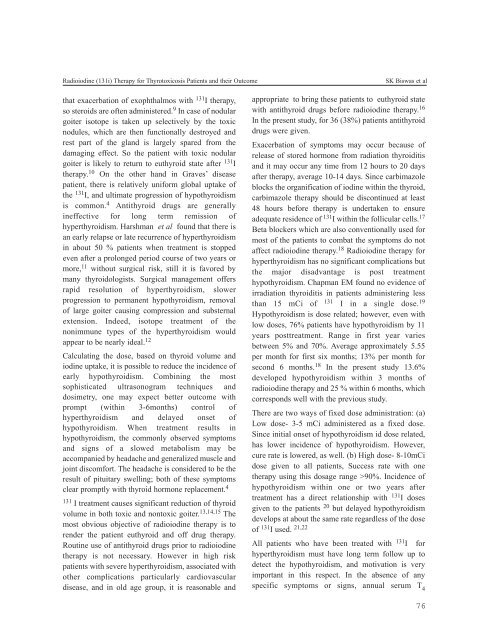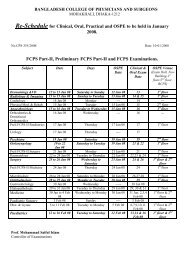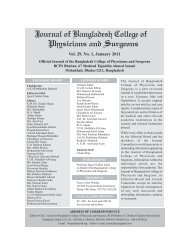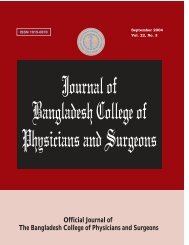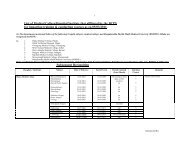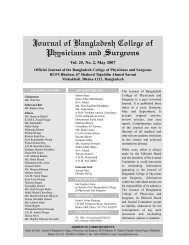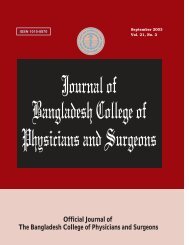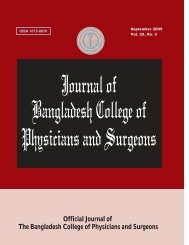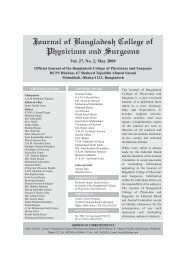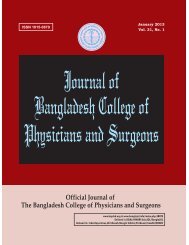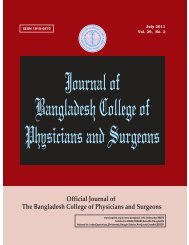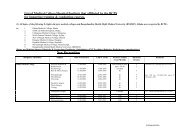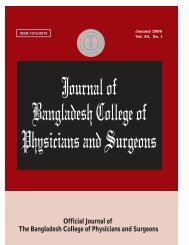May 2008 - bcps
May 2008 - bcps
May 2008 - bcps
Create successful ePaper yourself
Turn your PDF publications into a flip-book with our unique Google optimized e-Paper software.
Radioiodine (131i) Therapy for Thyrotoxicosis Patients and their OutcomeSK Biswas et althat exacerbation of exophthalmos with 131 I therapy,so steroids are often administered. 9 In case of nodulargoiter isotope is taken up selectively by the toxicnodules, which are then functionally destroyed andrest part of the gland is largely spared from thedamaging effect. So the patient with toxic nodulargoiter is likely to return to euthyroid state after 131 Itherapy. 10 On the other hand in Graves’ diseasepatient, there is relatively uniform global uptake ofthe 131 I, and ultimate progression of hypothyroidismis common. 4 Antithyroid drugs are generallyineffective for long term remission ofhyperthyroidism. Harshman et al found that there isan early relapse or late recurrence of hyperthyroidismin about 50 % patients when treatment is stoppedeven after a prolonged period course of two years ormore, 11 without surgical risk, still it is favored bymany thyroidologists. Surgical management offersrapid resolution of hyperthyroidism, slowerprogression to permanent hypothyroidism, removalof large goiter causing compression and substernalextension. Indeed, isotope treatment of thenonimmune types of the hyperthyroidism wouldappear to be nearly ideal. 12Calculating the dose, based on thyroid volume andiodine uptake, it is possible to reduce the incidence ofearly hypothyroidism. Combining the mostsophisticated ultrasonogram techniques anddosimetry, one may expect better outcome withprompt (within 3-6months) control ofhyperthyroidism and delayed onset ofhypothyroidism. When treatment results inhypothyroidism, the commonly observed symptomsand signs of a slowed metabolism may beaccompanied by headache and generalized muscle andjoint discomfort. The headache is considered to be theresult of pituitary swelling; both of these symptomsclear promptly with thyroid hormone replacement. 4131 I treatment causes significant reduction of thyroidvolume in both toxic and nontoxic goiter. 13,14,15 Themost obvious objective of radioiodine therapy is torender the patient euthyroid and off drug therapy.Routine use of antithyroid drugs prior to radioiodinetherapy is not necessary. However in high riskpatients with severe hyperthyroidism, associated withother complications particularly cardiovasculardisease, and in old age group, it is reasonable andappropriate to bring these patients to euthyroid statewith antithyroid drugs before radioiodine therapy. 16In the present study, for 36 (38%) patients antithyroiddrugs were given.Exacerbation of symptoms may occur because ofrelease of stored hormone from radiation thyroiditisand it may occur any time from 12 hours to 20 daysafter therapy, average 10-14 days. Since carbimazoleblocks the organification of iodine within the thyroid,carbimazole therapy should be discontinued at least48 hours before therapy is undertaken to ensureadequate residence of 131 I within the follicular cells. 17Beta blockers which are also conventionally used formost of the patients to combat the symptoms do notaffect radioiodine therapy. 18 Radioiodine therapy forhyperthyroidism has no significant complications butthe major disadvantage is post treatmenthypothyroidism. Chapman EM found no evidence ofirradiation thyroiditis in patients administering lessthan 15 mCi of131I in a single dose. 19Hypothyroidism is dose related; however, even withlow doses, 76% patients have hypothyroidism by 11years posttreatment. Range in first year variesbetween 5% and 70%. Average approximately 5.55per month for first six months; 13% per month forsecond 6 months. 18 In the present study 13.6%developed hypothyroidism within 3 months ofradioiodine therapy and 25 % within 6 months, whichcorresponds well with the previous study.There are two ways of fixed dose administration: (a)Low dose- 3-5 mCi administered as a fixed dose.Since initial onset of hypothyroidism id dose related,has lower incidence of hypothyroidism. However,cure rate is lowered, as well. (b) High dose- 8-10mCidose given to all patients, Success rate with onetherapy using this dosage range >90%. Incidence ofhypothyroidism within one or two years aftertreatment has a direct relationship with 131 I dosesgiven to the patients 20 but delayed hypothyroidismdevelops at about the same rate regardless of the doseof 131 I used. 21,22All patients who have been treated with 131 I forhyperthyroidism must have long term follow up todetect the hypothyroidism, and motivation is veryimportant in this respect. In the absence of anyspecific symptoms or signs, annual serum T 476


